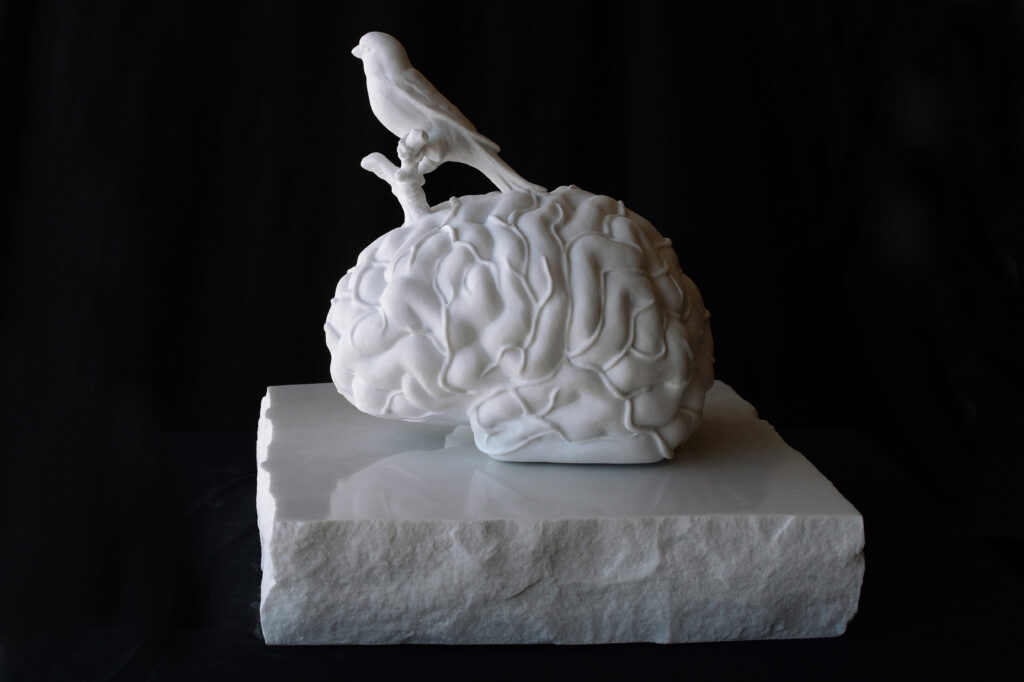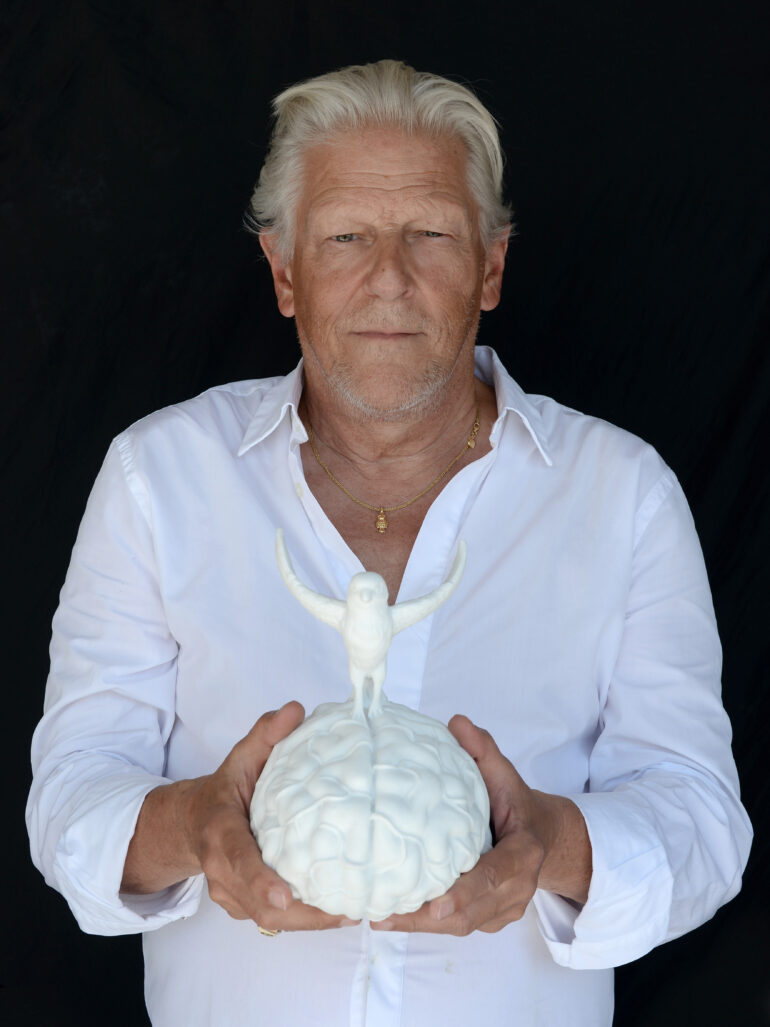Culturalee talks to Belgian artist Jan Fabre as he opens a major new solo exhibition during Frieze Week in London at Mucciaccia Gallery. Titled ‘Song of the Canaries: A Tribute to Emiel Fabre and Robert Stroud ‘, the exhibition features a new version of Fabre’s seminal 1998 work ‘The Man Who Measures The Clouds’.
Your new solo exhibition at Mucciaccia Gallery will feature sculptures made from Carrara marble. Some of the most important sculptors of all time sculpted with Carrara marble, most famously Michelangelo. Do you find it challenging to carve into marble, and are you inspired by the masters of Renaissance sculpture?
I always want to approach my art in an innovative way, challenging traditional forms and materials. There is no avant-garde without tradition. For example, in my exhibition Pietàs at the Venice Biennale a few years ago, I combined the long artistic heritage of classical sculpture and iconography with a contemporary interpretation and scientific approach to the themes of empathy, imitation and compassion inspired by the research of the Italian scientist Giacomo Rizzolati. This reinterpretation of classical forms allows me to enter into a dialogue with the past, inviting the public to reflect on the luxury of memory and the mirror neurons.
Renaissance artists such as Michelangelo and Gian Lorenzo Bernini often used Carrara marble for its exquisite quality and translucency. My choice of the same material is a tribute to the craftsmanship and techniques developed during the Renaissance, when marble was not just a medium but a means of achieving beauty and divine expression. All my marble sculptures are hand carved. The white Carrara marble from the type Michelangelo Bianco Pure that I use for my sculptures reminds me of breastmilk. The material is very sensual.
The exhibition has an intriguing title – Song of the Canaries: A Tribute to Emiel Fabre and Robert Stroud – can you explain the story behind it?
In the exhibition Songs of the Canaries, I present a series of white Carrara marble sculptures featuring canaries sitting on top of a human brain, almost as if they grew from the veins of the brain. It is a contemplation of my ‘conscilience’ thinking.
The links between the series of marble brains with canaries and Robert Stroud is that Robert Stroud was an important ornithologist specialized in canaries. And the exhibition is also an homage to my deceased brother Emiel Fabre.

The London exhibition will feature a new version of your seminal 1998 work ‘The Man Who Measures The Clouds’, which was exhibited at La Biennale di Venezia, SMAK in Ghent, deSingel in Antwerp, Brussels Airport, and the 21st Century Museum of Contemporary Art in Kanazawa. Could you give a bit of insight into the updated version ‘The Man Who Measures His Own Planet (2024)?
For the new sculpture The Man Who Measures His Own Planet I opened the skull, so you can see the brain inside. So I am not only measuring the clouds but also my own brain. The sculpture also serves as a tribute to Robert Stroud, the Birdman of Alcatraz, a prisoner who became a renowned ornithologist, specializing in canaries. Stroud was given birds to study in his cell, and even in captivity, these creatures found the strength to sing and inspire the mind. Upon his release, when asked by journalists what he planned to do with the rest of his life, Stroud replied, “I am going to measure the clouds.”
Your new sculptures feature canaries positioned on human brains, using the bird as a metaphysical symbol. During the 20th century, canaries were used in the coal mining industry to notify the miners of carbon monoxide in the mines. They were essentially sacrificed to save the miners, because a canary collapsing meant the workers knew there was poisonous gas in the air. Do you think humans and birds have a slightly troubled relationship?
In my thinking, birds and all other animals are the best doctors and philosophers on this planet. We still can learn a lot from them. And it is true that animals often save the lives of human beings, as did the canaries used by the coalminers. The exhibition Songs of the Canaries takes on a deeper significance when considering the Flemish phrase “The canary is singing too loud in his brain”. Here, I make a reference to my brother Emiel’s fatal childhood disease. This exhibition at the Mucciaccia Gallery in London is a proposal to immortalize my brother’s spirit, capturing the essence of someone forever striving toward the infinite while attempting to measure the immeasurable. Ultimately, this exhibition is as a poetic tribute to the fragility of life and the vulnerability of beauty. It defends the vulnerability of animals and humans.
As well as sculpture, your practice includes performance and theatre, and you put on a monumental 24-hour performance called ‘Mount Olympus’ in 2015. Have you always been working across different artistic disciplines, and how do they interplay with each other?
Theatre and visual arts are two different media with their own tools, memories and histories. I am not a multimedia or hybrid artist, I am a ‘conscilience’ artist. Conscilience as defined by the philosopher, biologist and entomologist Edward O. Wilson. Literally a ‘jumping together’ of knowledge by linking facts and fact-based theory across disciplines to create a common basis of explanation and generate new interpretations. I also made a film with Edward O. Wilson called Is the brain the most sexy part of the body (2007).
As a ‘conscilience’ artist I can see the connections between the different media I use and by analysing the connections I can give new interpretations to each medium. For example, I learn from the kinetic intelligence of my actors and dancers for my sculptures. Another example is that my visual art installations often inspire the stage design of my theatre creations.
My natural state of being leads me to work with people in the theatre during the day, sharing energy and ideas, and at night I work in solitude, in dialogue with the material I have chosen for my visual art. With my theatre company Troubleyn we have been working for 2 years on a new 24-hour performance called The Mystic Cycle. The world premiere of this new theatre creation will be in the summer of 2026.
You were born in Antwerp and have enjoyed a 40 year career with exhibitions all over the world. There is a rich artistic heritage in Belgium and an exciting contemporary art scene, and high profile Belgian artists such as you and Koen Vanmechelen making an impact internationally. What excites you about the Belgian contemporary art scene at the moment?
Yes, I have been working as a visual artist, theatre artist and author for more than 40 years. I have presented my work in the best museums and theatre festivals around the world. This experience has given me a lot of freedom as an artist. And I am even more aware today that it takes a lifetime to become a young artist.
What unites the Belgian art scene is that the excellent Belgian artists are all individual and independent, they each have their own universe. I belong to a fantastic generation of Belgian artists. In the visual arts, I really respect the work of painters Michael Borremans and Thierry Decordier, and installation artists and sculptors Berlinde De Bruyckere and Koen Vanmechelen. In theatre and dance, I admire the work of the Ultima Vez dance company by Wim Vandekeybus and the Abattoir Fermé theatre company.
Jan Fabre ‘Song of the Canaries: A Tribute to Emiel Fabre and Robert Stroud ‘ is at Mucciaccia Gallery, 21 Dering Street, London W1S 1AL from 12th October to 23rd November, 2024.
www.mucciaccia.com



